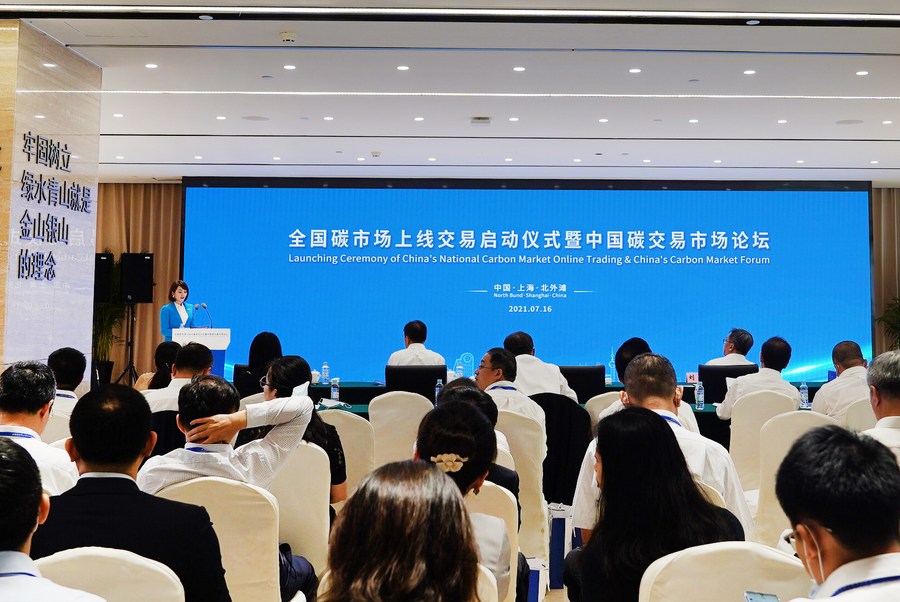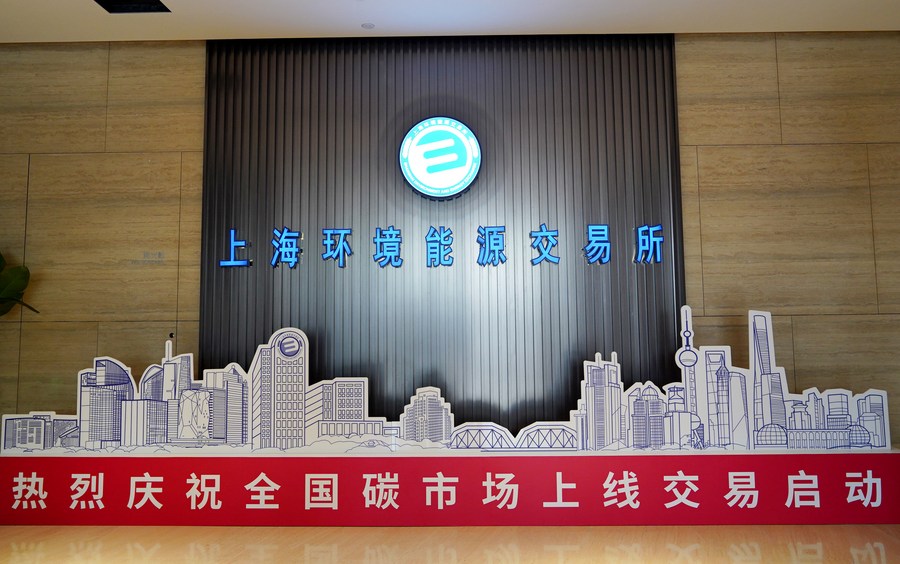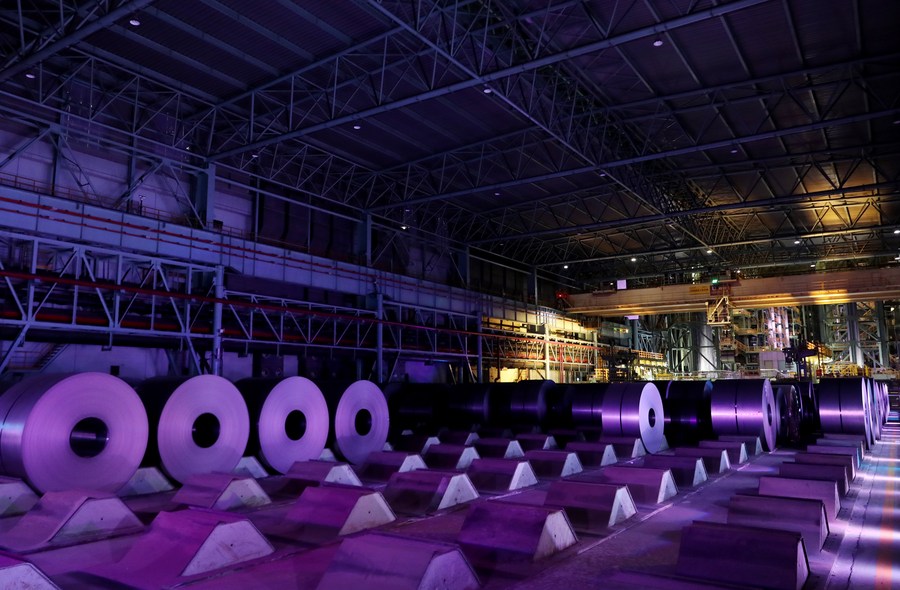World's largest carbon trading market mirrors China's green commitment
* China's national carbon market saw its total trading volume reach 194 million tonnes since its launch one year ago, according to the Shanghai Environment and Energy Exchange statistics on Saturday.
* Experts noted that the market, the world's largest in terms of the amount of greenhouse gas emissions covered, is expected to include more enterprises from emission-intensive sectors and see increasingly active trading as companies improve green awareness.
* The market in the first year includes 2,162 power-generating enterprises, covering about 4.5 billion tonnes of CO2 emissions. The market wrapped up its first compliance period on December 31, 2021, with the compliance rate reaching 99.5 percent.
SHANGHAI, July 16 (Xinhua) -- China's national carbon market saw its total trading volume reach 194 million tonnes since its launch one year ago, according to the Shanghai Environment and Energy Exchange (SEEE) statistics on Saturday.
Experts noted that the market, the world's largest in terms of the amount of greenhouse gas emissions covered, is expected to include more enterprises from emission-intensive sectors and see increasingly active trading as companies improve green awareness.

Participants attend the launching ceremony of China's national carbon market online trading and China's Carbon Market forum in east China's Shanghai, July 16, 2021. (Xinhua/Cheng Siqi)
The national carbon market was launched on July 16, 2021, as an important scheme for China to reduce its carbon footprint and meet emissions targets -- it aims to peak CO2 emissions before 2030 and achieve carbon neutrality before 2060.
Carbon trading is the process of buying and selling permits to emit carbon dioxide or other greenhouse gases, and is restricted to designated emitters who have such rights.
Over the past year, the carbon market has run smoothly overall with a slight increase in trading prices, noted Vice Minister of Ecology and Environment Zhao Yingmin at the China International Carbon Trading Conference held Saturday in Shanghai. The carbon price opened at 48 yuan (7.1 U.S. dollars) per tonne on the first trading day and is around 60 yuan per tonne recently.
The market in the first year includes 2,162 power-generating enterprises, covering about 4.5 billion tonnes of CO2 emissions. The market wrapped up its first compliance period on December 31, 2021, with the compliance rate reaching 99.5 percent.

Photo taken on July 16, 2021 shows a view of the Shanghai Environment and Energy Exchange in east China's Shanghai. (Xinhua/Cheng Siqi)
According to the overall plan of the Ministry of Ecology and Environment, from 2021 to 2025, the national carbon market will cover eight high-energy-consuming industries, including power generation, iron and steel, construction materials, non-ferrous metals, petrochemicals, chemicals, paper manufacturing, and aviation, with a total of approximately 8,500 large emission-intensive enterprises.
Lai Xiaoming, chairman of the SEEE, said the market is also expected to become multi-leveled, the pricing mechanism will become more scientific and reasonable with the market system in place.
GROWING GREEN AWARENESS
"The biggest impact of the national carbon market lies on improving the awareness of carbon neutrality among high-emission enterprises and their managers," said Meng Bingzhan, deputy general manager of SinoCarbon Innovation & Investment.
The national carbon market has fueled an increase in transactions of China Certified Emissions Reductions(CCER), with companies' voluntary reduction of emissions achieved via means such as afforestation or employing clean energy technologies.

Photo taken on March 18, 2022 shows a carbon emission supervision platform in Xiongan New Area, north China's Hebei Province. (Xinhua/Zhu Xudong)
Statistics from the SEEE showed that in 2021, the cumulative trading volume of CCER was about 170 million tonnes, up about 1.7 times from the previous year.
"The price set at the carbon market sends a clear signal that emission costs, and should be factored in," Meng said, adding that some companies are even considering the reduced emission as profits.
Wu Wenzhang, general manager of Steelhome, an online business information platform for the steel industry, said China's carbon goals mean a reshuffling for the industry. "In the future, steel enterprises that can achieve ultra-low emission and environmentally-friendly production can have a broader space for development," he said.

Photo taken on Feb. 8, 2022 shows a view of the intelligent workshop of Baoshan base of China Baowu Steel Group in east China's Shanghai. (Xinhua/Fang Zhe)
China Baowu Steel Group, the world's largest steel conglomerate, is exploring using hydrogen to power its metallurgical process in one of its green, low-carbon projects.
The project has completed the first two experimental phases. The phase-three experiment will mark the beginning of attaining the planned capacity to achieve more than a 30 percent reduction in carbon emission.
Shen Yizhu, CEO of Xoeytech, a carbon-related service provider in the construction industry, said though the industry has not yet been included in the national carbon market, leading enterprises in the real estate industry and the supply chain of the industry have an increasing demand for low-carbon solutions over the past year.
According to the corporate information provider Tianyancha, more than 9,800 enterprises are providing carbon-related services in China, over 1,800 of which were established in the past year. Over 800 such enterprises have been set up so far this year, up 19.4 percent year on year.
Photos
Related Stories
- China steps up energy conservation, carbon reduction efforts in industrial production
- China cuts carbon emissions per unit of GDP by half from 2005
- China's five-year bioeconomy plan to focus on low-carbon growth, epidemic prevention
- China science, technology news summary -- May 8
- Agricultural sector key to carbon goals
Copyright © 2022 People's Daily Online. All Rights Reserved.









